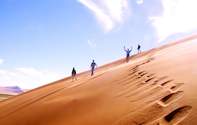
Namibia's many parks and game reserves are of 2 basic types. Some, such as the well-known Etosha National Park, are like most southern African parks, focused primarily on game.
Others, including the coastal parks and Fish River Canyon, are are spectacular wilderness areas, where the beauty of the scenery easily upstages the game. The descriptions that follow are for only a selected few of Namibia's many fine parks.
Geography and Climate
Namibia comprises four major geographic regions:
Etosha Pan, in the north. An enormous alluvial plain which no longer contains the lake that it once held. Water supplies are now limited to the perimeter of the pan for most of the year, yet the area remains sufficiently fertile to support great herds of antelope species such as Springbok, Gemsbok and Impala. Zebra, abound and, inevitably the Elephants that make the Pan famous.
Etosha Pan is now the centre of one of the finest game parks on the African continent, with many other species of wildlife in abundance.
The Namib Desert along the Namibian coast, is spectacularly barren, with brilliant red sandscape divided into the Skeleton Coast in the north and the Diamond Coast in the south. This coastal desert is the richest source of diamonds on the planet, resulting in Namibia is the world's largest diamond producer that makes it quite unlike any spot on earth.
The dry and hot Namibian shoreline is situated right at the point where the icy waters of the Atlantic hit the continent--Antarctic water meets the African desert, and the result is often extremely dense fog. A fog that has resulted in numerous shipwrecks over the centuries - hence the name 'Skeleton Coast'. Namib-Naukluft National Park is now sited on this coast (49 000 square km).
Caprivi Strip in the northeast is a portion of Namibian territory that extends between Angola and Botswana as a slender corridor. It is a wooded and fertile region crossed by a number of rivers and is unlike the rest of Namibia. The River Zambezi and the River Okavango, rank among the great rivers of Africa. The strip is also the site of several game parks, which while not offering such an abundance of wildife certainly provide spectacular scenery and relative solitude.
The central high escarpment plain is Namibia's heart and is occupied by Windhoek, the capital and the only city of any size. The northern part of this central plain is the Waterberg Plateau, a 400 square km shelf that rises 150 metres straight from the surrounding plain. Well-watered and lush, it is home to several rare and endangered species.
Namibia's southern region is the location of the second-largest canyon in the world, the immense Fish River Canyon. Second to the Grand Canyon, Fish River Canyon offers magnificent vistas and great, though strenuous hiking. Daytime heat, rather than rain, is the primary concern for most travellers to Namibia. While temperatures are generally comfortable year-round, the warmest season is the period extending from November to March.
History and People of Namibia
Namibia is populated by few people, but those few constitute an unusually diverse set of peoples and cultures. The country's predominant (85%) black population is composed of several different ethnic groups, including the San, the Khoi-Khoi, the Herero, and the Ovambo.
The small European population is composed of Germans and Afrikaners, and there is also a significant Asian minority. The great majority of Namibia's 1.5 million people live in the north, where there the climate is less arid and generally more hospitable.
The history of habitation in Namibia begins with the San people (Bushman), who were living there at least 2 thousand years ago. As a nation, however, Namibia is relatively young, having gained its independence after prolonged struggles only in march of 1990. The country was largely spared the attentions of the European powers until the end of the nineteenth century when it came under the control of Germany.
In 1920 the territory was awarded by the League of Nations to South Africa, which resisted Namibian independence for decades as a result of the area's enormous mineral wealth. Although the UN voted to end South African control in 1966, widespread regional warfare prevented the establishment of an independent government for almost 2 decades.

 The attractions of Namibia include incredibly beautiful desert-scapes and unique scenery which attract vast numbers of visitors each year....
The attractions of Namibia include incredibly beautiful desert-scapes and unique scenery which attract vast numbers of visitors each year....